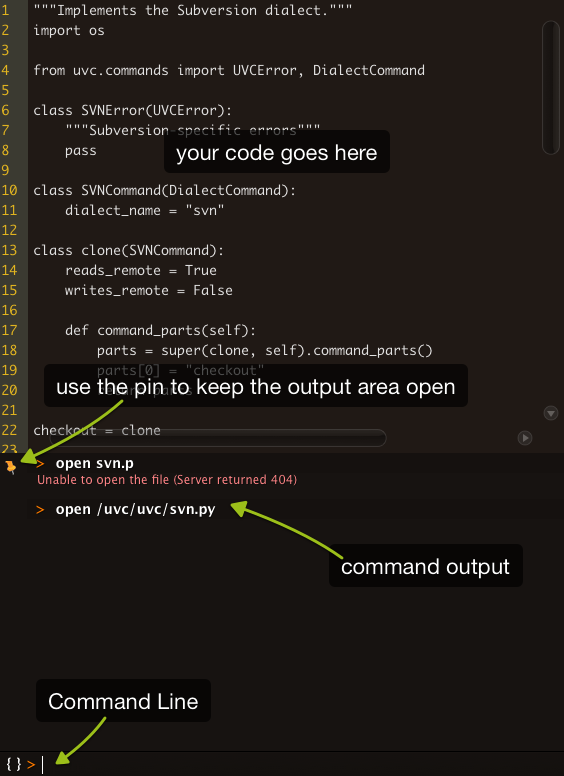Bespin User's Guide
Introduction
What Is Bespin?
Bespin aims to be a top-of-the-line text editor that lives in your browser. It is based on the latest web standards that are shipping in modern browsers.
Requirements
Bespin requires a "modern browser" with support for HTML5 and specifically the Canvas element with the ability to draw text. Our current list of supported browsers is:
- Firefox 3.5+
- Chrome 2.0+
- Safari 4.0+
How Can I Use Bespin?
Depending on what you're trying to accomplish and how much time you're willing to invest, there are several ways in which you can use Bespin:
- use https://bespin.mozillalabs.com without downloading anything
- download Bespin Embedded for use in your own applications
- set up your own Bespin server (not for the faint of heart!)
This guide is primarily geared toward people using the Bespin server at bespin.mozillalabs.com, but there are topics covered that also apply in the other uses of Bespin.
Getting Help
Beyond this documentation, Bespin also has mailing lists and a feedback forum. Take a look at the Bespin Project homepage for links to these resources.
Getting Started
Create an account or log in at bespin.mozillalabs.com. Once you have logged in, your screen will look something like this:

As noted in the screenshot, the top part of the window is the editor itself. At the bottom of the screen is a command line, which you use to make Bespin do all kinds of things. When the cursor is in the command line, the command output is displayed. By default, when you're editing the output is not displayed so that you get more room for editing. There's a little pin in the upper left of the output window that you can click to pin the output and make it visible all the time.
Commands
Beyond basic typing, everything you do in Bespin is controlled by a "command". Commands can be entered on the command line, or invoked by keyboard control.
Over time, we expect to build additional user interface for working with commands. For now, it's enough to know that commands are how Bespin gets things done. One great thing about commands, as noted in the Plugin Guide, is that they're easy to write.
The help command is a useful command to know: it will list all of the
commands available to you right now. This Users Guide will mention some
commands in the context of larger topics, but the up-to-date list of
commands is available via help.
Keyboard Control
Bespin's keyboard controls are very configurable. A command can provide a default key binding. Those bindings can be changed by keymapping plugins and further through configurations that you set.
Any keybindings mentioned in this guide are subject to change by plugins
and configuration, so keep that in mind. Also, if we talk about cmd-J,
that means cmd-J on the Mac and ctrl-J on Windows.
Speaking of cmd-J, that is an incredibly useful shortcut. That will
bounce you back and forth between the editor and the command line. Since
the command line is an important part of Bespin's UI, you'll want to be
able to get there without having to reach for the mouse.
Working with Files
Bespin supports a filesystem of files and directories, just like any other
editor. You can use the cd command to change the current working directory
and display the current directory with pwd. All file commands like ls to display
a list of files in the current directory or open to open a file work hand
in hand with the current working directory. You can also address files from the
root like open /foo/bar.js.
The newfile command gives you a blank buffer to start coding in. You then use saveas to put that newfile in it's place.
You can delete a file or directory with the rm command. You should add a
trailing "/" whenever you want to work with a directory.
Use the open command to open a file. open features powerful completion
that works across all of your Bespin files (under the current working
directory) to find the best match.
Settings
Our plan is to make Bespin a very configurable editor. You can see the list
of available settings and change them by using the set command. It's important,
that settings are used the same on all instances of Bespin.
Bespin's History
The Bespin project was created by Ben Galbraith and Dion Almaer in 2008 and then brought to Mozilla Labs at the end of that year. Following the first public release in February 2009, the Bespin team (now a combination of Mozilla employees and open source contributors) produced a series of releases up to version 0.4.4 in September 2009. After that, the project "rebooted" the client side code to build a newer, better structure for adding the planned features. In November 2009, the first reboot code was released as Bespin Embedded 0.5. In April 2010, Bespin 0.7 became the first rebooted client/server release.